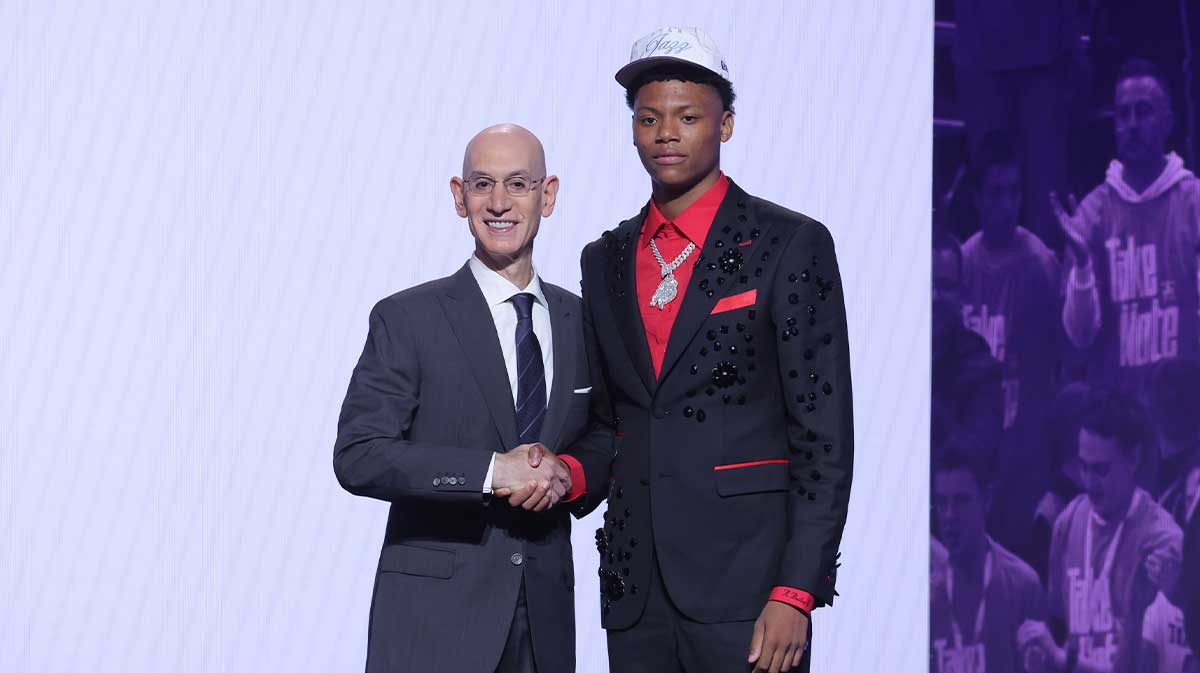Find your project's finishing piece at Everything But The House
Designers are forever searching for the elusive, unique, “where did you get that?” finishing touch—a one-of-a-kind item to elevate a project into a work of art and gild their reputation as gifted interpreters of clients’ dreams. But not every budget covers the cost of a trip to the Paris flea markets or antiques brokered through centuries-old London auction houses. Here’s the perfect solution: a colossal source of furniture, artwork, objets and oddities—basically, Everything But The House—at the ready to be rummaged through right here in America’s heartland. Stored in a 217,000-square-foot flagship warehouse in Blue Ash, Ohio, and—most accessible of all—online 24/7, EBTH’s diverse assortment of authenticated home goods and collectibles is largely curated from individual estates all over the country and listed with opening bids that won’t break the bank.
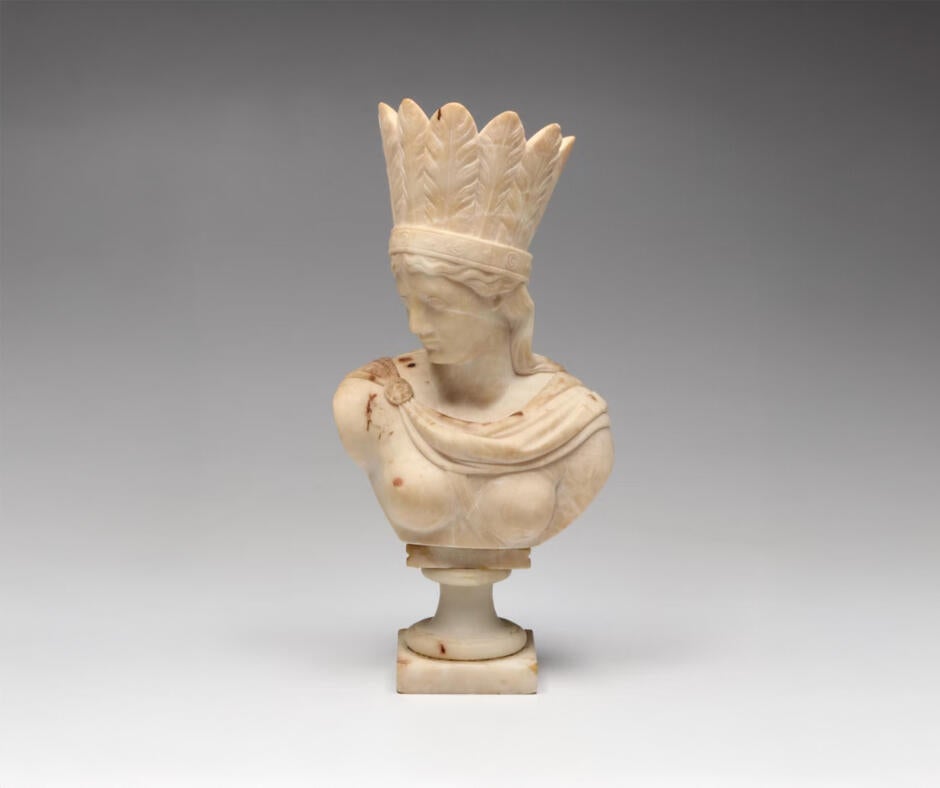
Mid-19th-century carved marble bust of “America”
Courtesy of EBTH
Established in 2008, the soup-to-nuts marketplace merges the talents of two seasoned entrepreneurs. Brian Graves, a collector turned dealer, got into the field when renovating his old Victorian home in the 1990s. “One of the first auctions I showed up at, someone held an ashtray in the air, and it sold for $400,” he says. “I was amazed anybody in their right mind would pay that much, so I started researching the underlying values of home furnishings and rapidly became an addict.” On the other side of the aisle—and for a few seasons on HGTV—Jacquie Denny was running her tag sale company, which helped families not only endure but profit from the arduous and emotionally draining ordeal of emptying a house. “Brian was at the front of the line of every auction I held,” says Denny. “I learned he was the most knowledgeable and kind shopper on the scene.” The two crossed paths so often that they soon realized their experience and skill sets made them an obvious fit for a business partnership.
“By the early 2000s, the dynamics of resale were changing,” says Graves. Items bought for a song at garage sales popped up on eBay and Craigslist as collectibles at the same time that a tidal wave of downsizing baby boomers began to divest themselves of their worldly possessions. “Supply was increasing, and demand was evolving due to the transparency of the internet,” he explains. Conditions were ripe for an accessible site connecting sellers and buyers, reaching a broader audience and simplifying every step.
GENERATIONAL CHANGE
Millennials may get a bad rap for defaulting to fast furniture in lieu of their grandparents’ heirlooms—leaving entire art deco bedrooms and midcentury dining sets for EBTH to reclaim—but as Graves and Denny have observed over the past two decades, the situation is not so black-and-white. Boomers, who had their children earlier and could actually afford a mortgage, filled their midlife empty nests with all kinds of keepsakes: some of real value, others just stuff. Younger generations, many of them renters, don’t have the square feet or fixed address in which to place everything being passed down. But that doesn’t mean they don’t appreciate select pieces.
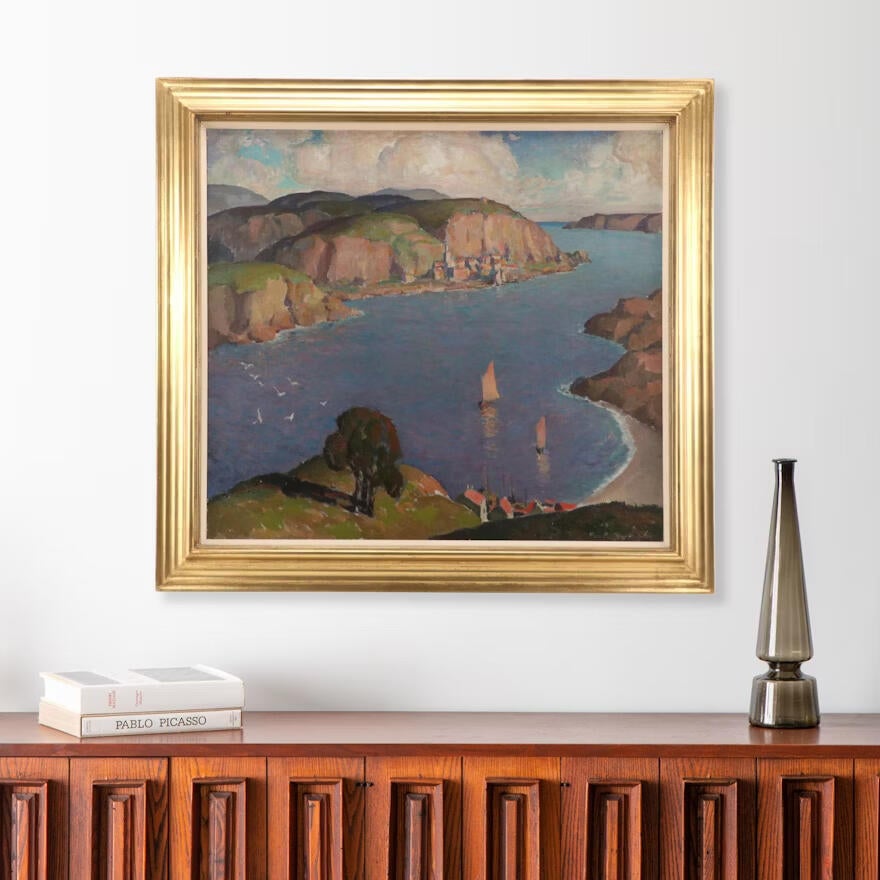
Larger than the artist’s usual works, this 1928 seascape by Frank Harmon Myers caused much excitement at auctionCourtesy of EBTH
“When we launched the business, I used to refer to the next generation as the throwaway society,” says Graves. “Rather than investing in a rug, they’d buy a cheap one from Ikea, and eventually discard it.” Now, though, he recognizes that boomers’ compulsion to collect can cross over into the realm of hoarding—“Volume is sometimes an issue”—while millennials and Zoomers prioritize function in their furniture and are concerned with sustainability. “They’re adopting the circular economy and see the benefits of buying from the secondary market,” he explains. It’s all pointing toward a mixed retail-resale future that balances the streamlined sterility of modern decor with striking recycled statement pieces—a style driven by influencers and interior designers.
“Years ago, I never could have predicted that ‘grandma chic’ would become a trend, but it can be traced back to the design community,” Graves continues. “There’s a whole generation leveraging Instagram and TikTok to repurpose furniture.” Making what’s old new again has always been part of the designer’s tool kit, but the sheer amount of information at their fingertips today enables them to tap into many different eras at once and combine them in highly individual ways.

Italian neoclassical lamp with reverse-painted shade
Courtesy of EBTH
“Designers are a beacon, shining a light on style directions to come,” says Denny. For EBTH, it’s a mutually beneficial situationship. Promotions on the site and its social media include designer-curated sales with original imagery showing how to incorporate idiosyncratic collectibles into a contemporary room scheme. The platform’s team of full-time treasure seekers takes cues from what they present as the next big thing, sourcing to meet the need they’ve created. After authenticating each item—“We have consigners and specialists in almost every discipline, from 15th century Asian artifacts to vintage Louis Vuitton,” she says—ETBH preps, photographs and posts it with a description that cites its provenance.
“Younger generations still collect furniture and homeware; they’re just more selective about what they surround themselves with,” Denny adds. “But they do love the convenience of online shopping.” EBTH brings the Saturday morning garage sale ritual to designers who’d rather browse in the comfort of their own pajamas, on the couch, coffee in hand.
BROWN FURNITURE AND RAINBOW FISH
EBTH offers more than 1,000 items on its site every day to a global audience of over 2 million registered users, selling between 27,000 and 30,000 lots per month, direct to the consumer. Demand determines the final price. For buyers, it’s an opportunity to score unusual finds at a fair deal, with items arriving in days. For sellers, it’s a means to clear out belongings quickly when facing a major life change—and make some money to help finance the transition. Graves estimates that about half of EBTH’s inventory comes from private homes, supplemented by overstock from furniture brands, as well as excess pieces from interior designers, stagers and other members of the trade. “Working with families, there’s no guarantee what type of inventory is going to come in, causing highs and lows by category or brand or style,” he says. “Designers are more consistent in what they provide, filling those gaps.”
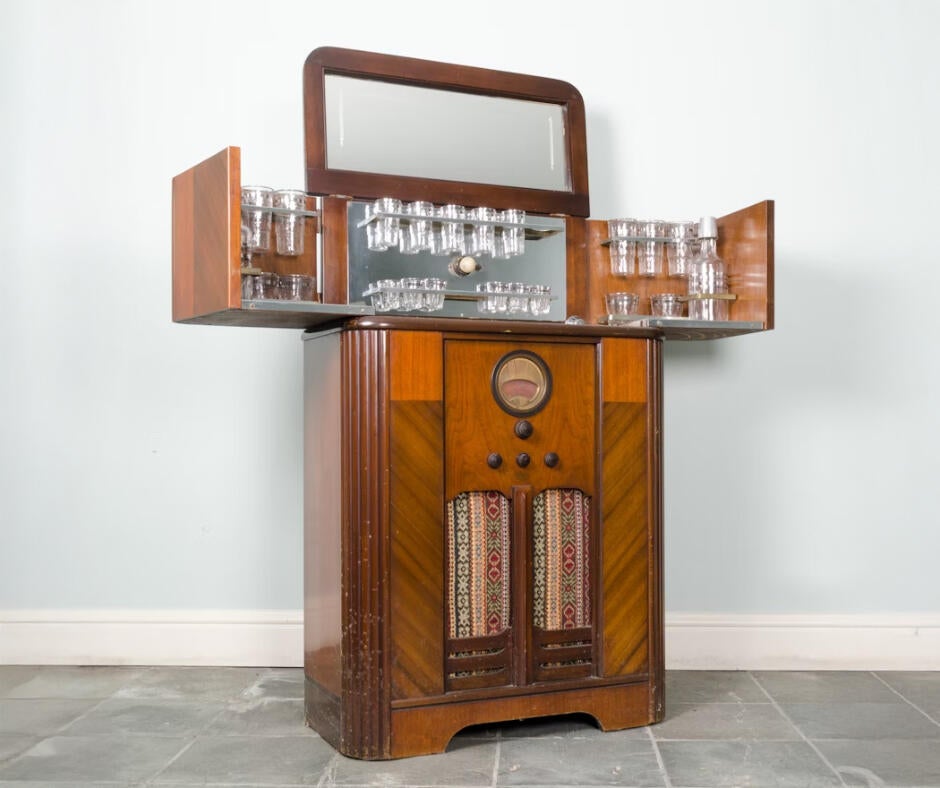
As baby boomers downsize, Everything But The House anticipates an influx of wood furniture, including art deco pieces
Courtesy of EBTH
Tracking analytics also informs how EBTH tailors its stock. “We have a robust search function. By keyword, aesthetic, estate: There are endless ways to filter. If someone says, ‘Hey, I’m only interested in Restoration Hardware,’ they can save that search and get notifications in their inbox every morning of newly available pieces,” Graves explains.
“Brown furniture is the biggest thing coming in right now, and it will continue to be for about another five years, because baby boomers heavily invested in cherry, mahogany and Queen Anne–style sets,” says Denny. In contrast to all that wood, boomers also indulged their every individual whim, compiling eclectic assortments of seashells, geodes, vintage Christmas ornaments, porcelain figurines, you name it. “We recently auctioned off a phenomenal collection of brightly colored, artisan-carved fish,” she says.
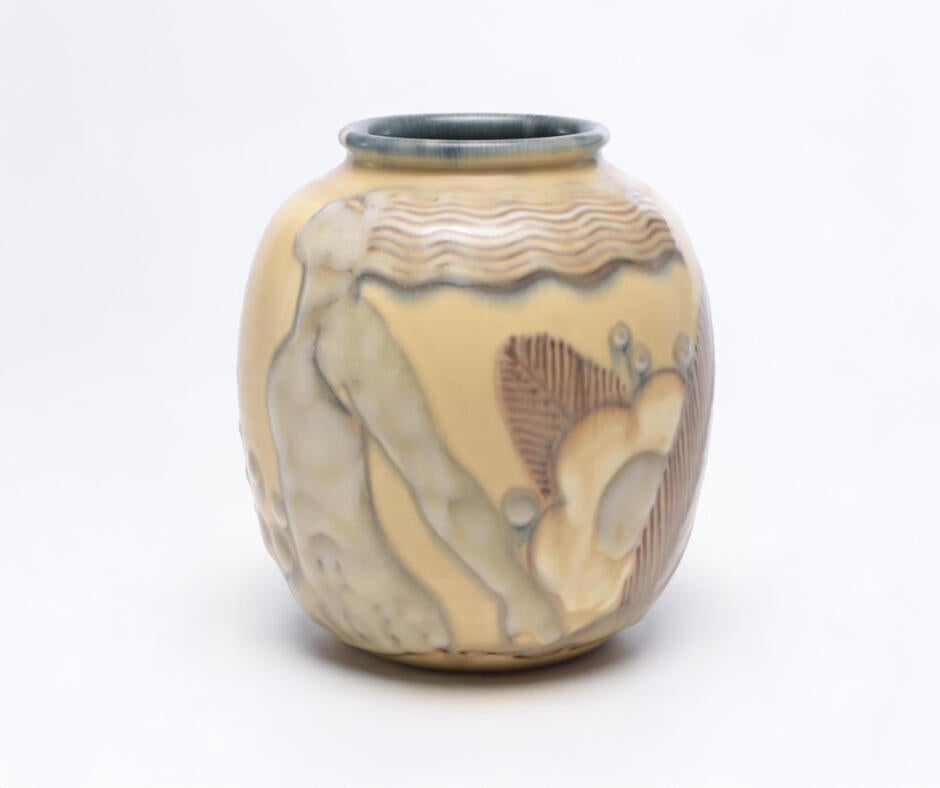
Circa 1931 William E. Hentschel art deco vase
Courtesy of EBTH
“Traditionally, had that collection come up at a local tag sale, the probability is it wouldn’t have found its audience,” says Graves. “But the EBTH platform hosts more than a million active users every day, and somebody somewhere, whether a design professional looking to complete a beach house or a hobbyist with a particular passion, will be looking for exactly that.” Fish-loving maximalists with a saved keyword search, place your bids!
With a projected $95 million in gross revenue this year—“Sales are going well, so we might break the $100 million mark,” says Graves—the appetite for the uncommon persists. “But the significance of an item isn’t always defined by its rarity or perceived value. It’s more personal than that,” he continues. He and Denny are often happily surprised by not only the veritable treasures they happen upon in people’s basements, attics and garages, but also how seemingly random objects that were never even on their radar end up resonating.
“You never know what’s waiting behind the door,” says Denny. Great big McMansions may be filled to the brim with beige particleboard, while an unassuming single-level conceals some astonishing booty. (A fully assembled dinosaur skeleton ranks high on the duo’s list of eyebrow-raising revelations.) “There’s no rhyme or reason, but every home represents an opportunity to match new customers with items these families have loved.” Designers can experience the thrill of acquiring their client’s private Rosebud—be it a cherished childhood toy or an Eames lounge chair in pristine condition. “Everything But The House has the piece that evokes a special memory or speaks to the heart,” says Denny. “It’s what makes all the difference when designing a home.”

A limited-edition cast-bronze bench by Claude Lalanne featuring a fantastical ginkgo leaf design fetched $401,000 Courtesy of EBTH
This story is a paid promotion and was created in partnership with Everything But The House.
Homepage image: A set of four Erwin-Lambeth tufted-leather, barrel-back chairs with naihead accent and a Regency-style pedestal table epitomize the preponderance of “brown” furniture in Everything But The House’s secondhand marketplace | Courtesy of EBTH
Want to stay informed? Sign up for our newsletter, which recaps the week’s stories, and get in-depth industry news and analysis each quarter by subscribing to our print magazine. Join BOH Insider for discounts, workshops and access to special events such as the Future of Home conference.









